Related Research Articles
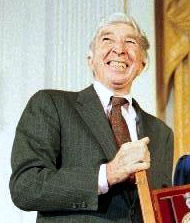
John Hoyer Updike was an American novelist, poet, short-story writer, art critic, and literary critic. One of only four writers to win the Pulitzer Prize for Fiction more than once, Updike published more than twenty novels, more than a dozen short-story collections, as well as poetry, art and literary criticism and children's books during his career.
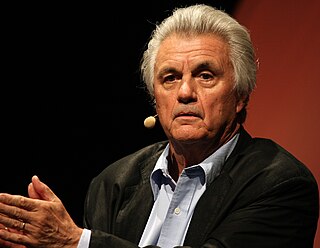
John Winslow Irving is an American-Canadian novelist and screenwriter.

Thomas Kennerly Wolfe Jr. was an American author and journalist widely known for his association with New Journalism, a style of news writing and journalism developed in the 1960s and 1970s that incorporated literary techniques.

American literature is literature predominantly written or produced in English in the United States of America and its preceding colonies. Before the founding of the United States, the British colonies on the eastern coast of the present-day United States were heavily influenced by English literature. The American literary tradition thus began as part of the broader tradition of English literature. However, a small amount of literature exists in other immigrant languages and Native American tribes have a rich tradition of oral storytelling.

Creative nonfiction is a genre of writing that uses literary styles and techniques to create factually accurate narratives. Creative nonfiction contrasts with other nonfiction, such as academic or technical writing or journalism, which is also rooted in accurate fact but is not written to entertain based on prose style.
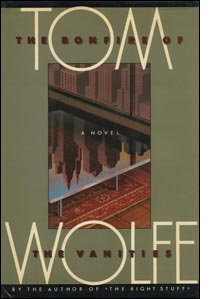
The Bonfire of the Vanities is a 1987 satirical novel by Tom Wolfe. The story is a drama about ambition, racism, social class, politics, and greed in 1980s New York City, and centers on three main characters: WASP bond trader Sherman McCoy, Jewish assistant district attorney Larry Kramer, and British expatriate journalist Peter Fallow.
New Journalism is a style of news writing and journalism, developed in the 1960s and 1970s, that uses literary techniques deemed unconventional at the time. It is characterized by a subjective perspective, a literary style reminiscent of long-form non-fiction and emphasizing "truth" over "facts", and intensive reportage in which reporters immersed themselves in the stories as they reported and wrote them. This was in contrast to traditional journalism where the journalist was typically "invisible" and facts are reported as objectively as possible. The phenomenon of New Journalism is generally considered to have ended by the early 1980s.

A Man in Full is the second novel by Tom Wolfe, published on November 12, 1998, by Farrar, Straus & Giroux. It is set primarily in Atlanta, with a significant portion of the story also transpiring in the East Bay region of the San Francisco Bay Area.

I am Charlotte Simmons is a 2004 novel by Tom Wolfe, concerning sexual and status relationships at the fictional Dupont University. Wolfe researched the novel by talking to students at North Carolina, Florida, Penn, Duke, Stanford, and Michigan. Wolfe suggested it depicts the American university today at a fictional college that is "Harvard, Yale, Princeton, Stanford, Duke, and a few other places all rolled into one."
James Douglas Graham Wood is an English literary critic, essayist and novelist.
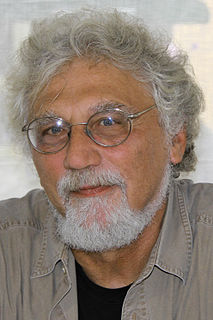
Bob Shacochis is an American novelist, short story writer, and literary journalist. He teaches creative writing at Florida State University.
Daniel Fuchs was an American screenwriter, fiction writer, and essayist.

Hooking Up is a collection of essays and a novella by American author Tom Wolfe, a number of which were earlier published in popular magazines.

Thomas Mallon is an American novelist, essayist, and critic. His novels are renowned for their attention to historical detail and context and for the author's crisp wit and interest in the "bystanders" to larger historical events. He is the author of nine books of fiction, including Henry and Clara, Two Moons, Dewey Defeats Truman, Aurora 7, Bandbox, Fellow Travelers, Watergate, Finale, and most recently Landfall. He has also published nonfiction on plagiarism, diaries, letters and the Kennedy assassination, as well as two volumes of essays.
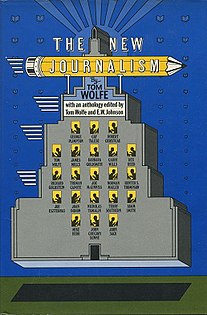
The New Journalism is a 1973 anthology of journalism edited by Tom Wolfe and E. W. Johnson. The book is both a manifesto for a new type of journalism by Wolfe, and a collection of examples of New Journalism by American writers, covering a variety of subjects from the frivolous to the deadly serious. The pieces are notable because they do not conform to the standard dispassionate and even-handed model of journalism. Rather they incorporate literary devices usually only found in fictional works.
The non-fiction novel is a literary genre which, broadly speaking, depicts real historical figures and actual events woven together with fictitious conversations and uses the storytelling techniques of fiction. The non-fiction novel is an otherwise loosely defined and flexible genre. The genre is sometimes referred to using the slang term "faction", a portmanteau of the words fact and fiction.

Visiting Mrs Nabokov is a 1993 collection of non-fiction writing by the British author Martin Amis.
"Why Bother?", originally published as "Perchance to Dream: In the Age of Images, a Reason to Write Novels", is a literary essay by American novelist Jonathan Franzen. It is often referred to as "The Harper's Essay". First published in the April 1996 issue of Harper's magazine, the essay concerns the persistence of reading within the context of technological growth and distraction. Franzen recounts his meditations on the state and possibility of the novel form, often against the backdrop of his personal experience, eventually concluding that the novel still has potential cultural agency in the United States, and often gains it by paradoxical drives of both culture and author.
A novelist is an author or writer of novels, though often novelists also write in other genres of both fiction and non-fiction. Some novelists are professional novelists, thus make a living writing novels and other fiction, while others aspire to support themselves in this way or write as an avocation. Most novelists struggle to have their debut novel published, but once published they often continue to be published, although very few become literary celebrities, thus gaining prestige or a considerable income from their work.

The literature of New England has had an enduring influence on American literature in general, with themes such as religion, race, the individual versus society, social repression, and nature, emblematic of the larger concerns of American letters.
References
- 1 2 3 Jack Miles (1989-11-12). "Endpapers: Tom Wolfe's Literary Manifesto: A Response". The Los Angeles Times .
- 1 2 Jonathan Yardley (1989-10-30). "For American Novelists, It's Time to Get Real". The Washington Post .
- ↑ "Tom Wolfe throws down a glove; Back to reality". The Economist . 1989-11-11.
- 1 2 3 Robert Towers (1990-01-28). "The Flap Over Tom Wolfe: How Real is the Retreat from Realism?". The New York Times .
- 1 2 Freddie Baveystock (1990-02-22). "Bonfire of the literary world". The Times .
- ↑ Charles Trueheart (1990-04-21). "Tom Wolfe, Taming His College Critics; Collection a Hopkins Degree & Defending the Harper's Essay". The Washington Post .
- 1 2 Lev Grossman (2004-11-08). "I am Still Tom Wolfe". Time Magazine .
- ↑ Craig Offman (2000-01-21). "Tom Wolfe calls Irving, Mailer and Updike "the Three Stooges"". Salon.com.